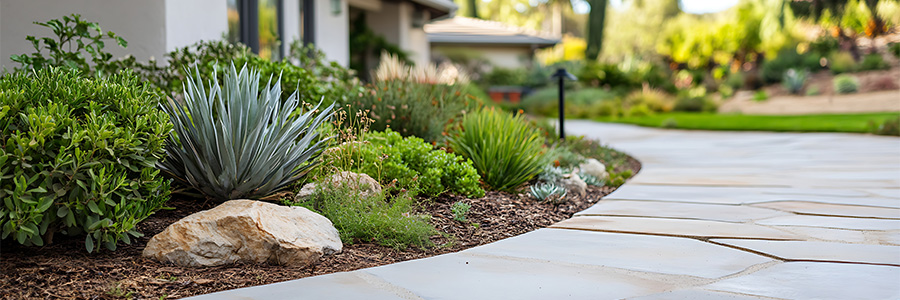
In the Southwest, where water is becoming more scarce with every passing year of Megadrought, xeriscaping has become the predominant landscape of choice. Water-wise and visually-appealing, xeriscaping is a landscape designed with native, drought-tolerant desert plants and succulents, colorful rocks, pavers and pebbled pathways, anchored by lacy ferns and graceful palms—an exotic alternative to water-guzzling lawns and plants.
In the U.S., 50% of residential water usage goes towards landscaping and lawns. In the arid Southwest, it can be as high as 60%, due to evaporation, wind, and runoff caused by inefficient irrigation systems and methods. But homeowners can reduce landscape water consumption a whopping 50% to 75% by following the principles of xeriscaping.
The 7 Key Principles of Xeriscaping
- Design a landscape plan that is cost-efficient and functional. Position plants in shade for energy-efficiency and water conservation.
- Incorporate organic materials into soils to improve soil health and improve drainage–and possibly create terraces to collect rainwater.
- Minimize the use of thirsty grasses.
- Install a smart irrigation system that delivers just the right amount of water, only when needed—including rainwater collection, if possible.
- Apply organic mulching to prevent weed growth, reduce evaporation, maintain cooler soil temperatures, and nourish soil health.
- Select drought-resistant, native plantings that attract wildlife, birds and bees, and are visually-appealing.
- Practice mindful maintenance by preventing excessive water use and fertilizing practices, and avoiding over-pruning.
Top Drought-Tolerant Plants for Colorful Xeriscaping
- Prickly Pear Cactus – A classic desert plant with broad, flat green pads. Yellow flowers emerge in May-June. Produces bright red fruit, beginning in July.
- Red Yucca – Stunning, drought-resistant plant with fiery red blooms.
- Desert Marigold – Individual yellow florets form a two-inch dense head to look like a single flower.
- Desert Willow – Small, multi-trunk tree with fragrant, trumpet-shaped flowers in shades of pink, lavender and white.
- Texas Ebony Tree – Remarkably drought-tolerant, decorative tree that grows to 30 feet tall with equal spread. Cream-colored clusters of fragrant flowers, produced late Spring to Fall.
- Brittlebush – Fragrant green-white, grayish leaves covered with yellow daisy flowers that attract butterflies and birds that eat the seeds.
- Agave – Long, spikey leaves with stunning rosette formations, and majestic, tall blooms.
- Blue Grama Grass – Forms short, three to six-inch grass that requires only seven inches of water per year. Produces beautiful, 10-inch seed stem if left unmown during flowering period.
How Xeriscaping Saves Money
- Drought-tolerant, native plants require little to no watering, saving significant money on the water bill. Grouping plants based on water requirements (hydrozoning) further reduces overwatering.
- Xeriscaping can reduce your water bill up to 80%. In California, some homeowners are saving more than 120 gallons of water a day by xeriscaping. In Flagstaff, Arizona, homeowners are saving an average of 8,000 gallons of water a year– $275.00 a year.
- Xeriscaping reduces yearly lawn maintenance costs (gas for lawn mower, fertilizer, etc.) a whopping 87%. Mulch and rocks prevent most weed growth, and most ground covers, such as sedum and sage, only need occasional trimming.
- Native plants, rocks, pavers are much cheaper than sod or artificial grass.
- Colorful and exotic Xeriscaping adds eye-catching curb appeal to a property—which can attract future, savvy buyers.
- Because it is gaining popularity as a more sustainable type of landscaping, Xeriscaping can improve property values by 14%.
How Xeriscaping Benefits the Environment
- Reduces outdoor water use to decrease strain on the water supply, and preserves dwindling water resources.
- Reduces use of fertilizer, so less chemicals are flowing into lakes and rivers. Native plants can thrive in soils and local climate they have adapted to, and can resist local pests and diseases without pesticides.
- Native plants create habitats and promote biodiversity for wildlife, birds, bees and pollinators with food sources they need.
Xeriscaping is Not Zero-Scape
While Zero-Scape means the complete absence of water use, Xeriscaping utilizes water-efficient strategies, and drought-tolerant, native plants to minimize water consumption while creating a vibrant landscape.
Xeriscaping Means Efficient Irrigation
Inefficient irrigation systems and methods waste as much as 50% of water used, due to overwatering and runoff. But smart, weather-based irrigation eliminates water waste, based on site-specific data from ET Everywhere, the most precise, accurate weather service available.
Unlike traditional, pre-programmed irrigation systems, cloud-based Smart Irrigation optimizes by microclimate, plant, soil, sprinkler type and slope to create specific schedules, depending on plant needs, and irrigate only when necessary to save water and money.
Efficient irrigation also utilizes real-time soil sensor data below ground to keep roots hydrated—not waterlogged or underwatered. Using patented technology, soil moisture sensors read soil moisture levels where it matters, in the root zone of the plant.
These ultra-sensitive sensors can take soil moisture level readings within + 3% of the actual volumetric soil moisture content, and electronically send readings to the Smart Irrigation Controller. Soil moisture sensors save money, because they reduce water usage up to 62% or more over traditional irrigation methods.
According to the United Nations, global freshwater demand is predicted to exceed supply by 40% by the year 2030, that urgent action must be taken by humans collectively to stop the imminent water crisis.
Clearly, Xeriscaping can help– by massively cutting outdoor water consumption by 50-75%, which in turn will conserve more freshwater for drinking in years to come.

